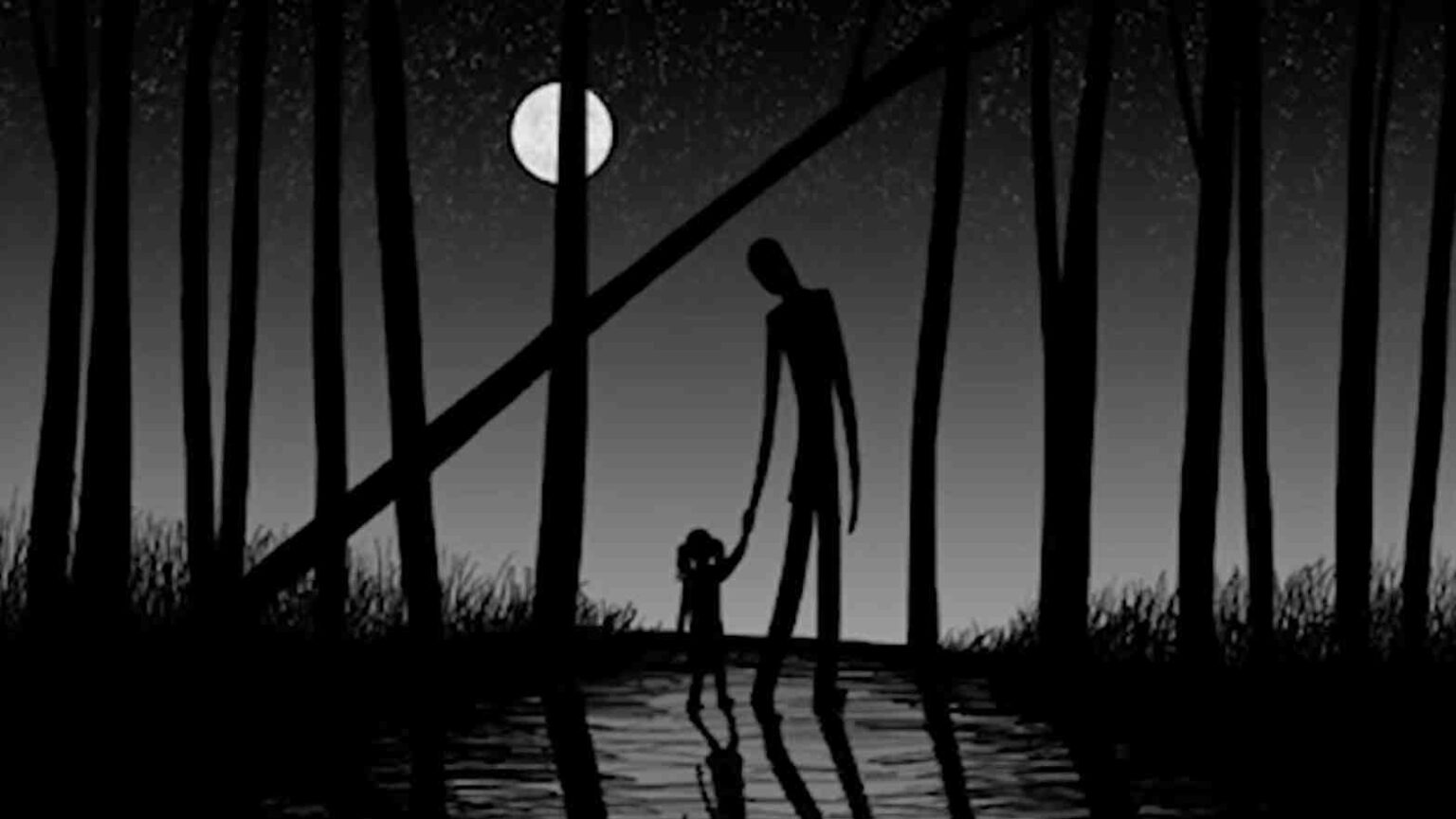
How did Slenderman inspire a stabbing spree?
With a mystifying blend of innocence and dread, the 2014 Slenderman stabbing made the lines between macabre fiction and unvarnished reality uncomfortably thin. Two fresh-faced, 12-year-old girls—bewitched by the lore of an eerie, web-born specter known as Slenderman—concocted a plot as bone-chilling as any peak television thriller to impress this digital boogeyman. This involved callously betraying their friend, Payton “Bella” Leutner, luring her into a Wisconsin woodland, and striking a horrific crime scene, scarily evocative of a Midsomer Murders episode turned twisted.

Shadow bites: real world horror
Waukesha, Wisconsin would never have been expected to make the headlines for a crime so chillingly surreal, something more at home in a Stranger Things episode than in this quiet, suburban landscape. But the scary truth of the matter is that virtual monsters have a way of clawing their way into reality, as the Slenderman stabbing grimly manifests.
The two girls, Anissa Weier and Morgan Geyser, were not your usual crime suspects. Born and bred in the heart of America, raised on a diet of Xbox games, and yet influenced by the Hammer Film Productions-era horror, a mix that proved to be a potent and dangerous cocktail. They royally shattered their idyllic setting, and the effects still reverberate.
Leaving no room for misinterpretation, we can consider this crime a chilling reminder of the pervasiveness of internet-based influences. An FHI360 report revealed how children’s online behavior directly correlates with their actions offline. The Slenderman stabbing is a living testament to this analysis – a haunting emblem of the blurred lines between fiction and reality.

Sacrifice to a cyber specter
What transpired was a tragic study in the pernicious power of internet lore, the Slenderman character—a suited, faceless figure of spindly menace—embodying a paranoiac digital legend exponentially spread by creepypasta.com. This event highlighted the disturbing vulnerability of young impressionable minds in the face of such uncurated online narratives. In an unsettling echo of Mindhunter‘s exploration into criminal behavior and psychology, the “Slenderman stabbing” case demonstrated the dark allure of fictive horror bleeding into real-world malfeasance.
Regrettably, the girls’ horrific sacrifice was part and parcel of a delusional quest to join Slenderman in his imaginary woodland mansion—a chilling plot whisked straight from the most demented telenovelas. In line with a tragic tableau worthy of David Fincher’s gloomy mise-en-scène, the victim, desperately clinging to life, managed a miraculous escape, albeit with wounds deeper than just physical.
Finally, thrust into the spotlight, this case became a sensation overnight and stoked heated debates on the profound socio-psychological implications. Scholars, media, and viewers alike grappled with the terrifying interplay between virtual terror and youth violence. The shockwaves of the Slenderman stabbing continue to ripple, proving a sobering testament to our requirement to vigilantly govern the digital wild west our young navigate daily. We must not let our life’s common stage become a grim Shakespearean tragedy.

Mystifying realm: straddling two realities
The Slenderman stabbing case serves as a reality-check, a stark reminder of the power interwoven in the pixels of the digital world to sketch a deadly blueprint. In 2014, Waukesha, Wisconsin – a sleepy suburban city became the somber stage where internet terror seeped into reality, inky tendrils releasing a horrific tableau that still sends shivers down our spines.
Anissa Weier and Morgan Geyser, the two 12-year-olds at the helm of this gut-wrenching event, were ordinary girls wrapped up in an extraordinary obsession. They are less the chilling offsprings of Stephen King’s parchments, and more by-products of an insidious cocktail: youthful naiveté, online fanaticism, and the disquieting lure of Slenderman – the pixelated boogeyman haunting the Internet’s shadows.
This grotesque stabbing casts a chilling spotlight on a lesser-tread area – the undeniable sway of the digital world on the tender minds of adolescents. A study by FHI360 drives this home by highlighting how children’s online behavior echoes in their offline actions. As we navigate the eerie labyrinth unfolding in the wake of the Slenderman stabbing, we can’t help but catch our reflection in the dark glass of digital influence – a stark parallel of dreaded fiction coming terrifyingly alive.

Drowning in digital darkness
Repercussions of the Slenderman stabbing continue to echo through our collective memory, a grim testament to the tenebrous corners of the internet where **_malevolent ideas_** thrive unchecked. This terrifying incident, a story that could’ve easily been plucked out from a stomach-churning episode of American Horror Story, was a grim indicator of the unchecked power of the Internet’s darkest corners and the profound influence they can exert on impressionable minds.
Two pre-teen girls, swept up in a macabre digital narrative, attacked an innocent peer in an attempt to appease a fictional internet beast. In a plotline that teeters uncomfortably close to a cult horror film, they sought to trade a life for a ride in the Slenderman’s mythical mansion, existing only in the shadowy realm they’d found on Creepypasta.com, a tale as unnerving as any Black Mirror episode’s exploration of technology’s grim underbelly.
The Slenderman stabbing case presents a juxtaposition between innocence and malevolence, a sinister coalescence that bears chilling similarities to The Soprano’s provoking crime narratives. It culminated in an attempted murder backed by a juvenile conviction to win over a virtual phantom. With the fine line between fiction and reality perilously blurred, it’s imperative we consciously broach the ethics and impacts of what we let float in this vast digital ocean.

Playing with shadowy soul snatchers
In the idyllic setting of Waukesha, Wisconsin, a chilling act echoed the kind of dark storyline usually reserved for the creepy realms of shows like Stranger Things. The reality, however, was far more terrifying – the Slenderman stabbing became a gruesome testament to the power that tales of virtual ghouls can hold over the impressionable minds of our youth.
Anissa Weier and Morgan Geyser, just 12 when they concocted this dreadful plot, were starkly unrepresentative of criminal suspects of yore. More familiar with the digital streets of their video games than they were with the yesteryear gore of Hammer House of Horror, they dared to cross the boundary dividing fiction from the grim reality of the Slenderman stabbing.
An FHI360 study confirmed a direct correlation between children’s online and offline behavior, and the Slenderman stabbing case carries this grim academic research into our collective consciousness. It’s a shrieking alarm, a grim portrait of the blurred lines between online fantasy and the offline world, reminding us of our duty to protect younger generations from the dark depths of the internet.
Studies in digital specters
The Slenderman stabbing set the stage for a horrific convergence of reality and digital folklore. The faceless figure, Slenderman, transformed from a harmless internet campfire story into an overbearing shadow of menace in real life. The consequences were gruesome, revealing the susceptibility of young, unsuspecting minds to unedited online narratives.
In macabre unison with the procedural explorations in Mindhunter, this case showed how easily internet horror can seep into corporeal reality, spawning unthinkable actions. Their shocking ‘offering’ to join Slenderman in his digital mansion reads straight out of a twisted telenovela script, with the nightmare ending only after their victim narrowly escaped death’s grasp.
The Slenderman stabbing not only haunted headlines, but also incited critical discussions about the profound social and psychological implications of unchecked internet consumption. The world grappled with the grotesque reality of children’s online immersion evolving into violent behavior. It serves as a devastatingly sobering reminder of the urgent need for careful oversight of the vast digital landscape our youth navigates.
Horror crossing reality’s threshold
The Slenderman stabbing case elevated the horrifying power of internet folklore, marking a sobering episode of how the shadowy depths of the digital world can manifest into bone-chilling reality. What occurred in 2014 was an unsettling incursion of an online horror story into the real-world comforts of Waukesha, Wisconsin.
Anissa Weier and Morgan Geyser became stark symbols of a modern horror tale, hapless adolescents consumed by their unsettling fascination for Slenderman. Their online obsession grew into a real-life nightmare, a chilling interplay of digital fanaticism, youthful innocence, and the nefarious grip of the internet’s very own boogeyman.
As outlined in an FHI360 study, the behavior of minors online can indeed have a notable impact on their actions in reality. The Slenderman stabbing case is a chilling embodiment of this theory, revealing how the digital world can manipulate pliable young minds. The reflection we see in this twisted mirror tells a cautionary tale of the escalating dread wrought by unchecked virtual influences.

Pixelated dread spills over
The Slenderman stabbing, a tragedy as haunting as any storyboarded for American Horror Story, looms as a chilling reminder of the influence the far reaches of the internet can wield over young, impressionable minds. Two seemingly ordinary girls, propelled by a sinister narrative, embarked on a horrifying mission to appease their digital idol, illustrating how insidiously destructive the unchecked corners of the internet can become.
Resembling a plot from the fevered mind of a horror fiction writer, their quest to exchange a human life for access to the fictional Slenderman’s ethereal mansion highlights the perilous journey from online obsession to real-world violence. As life echoes the chilling episodes of Black Mirror, this case underscores our collective responsibility to monitor, moderate, and guide our youth through the labyrinth of online narratives.
In conclusion, the Slenderman stabbing remains a somber testament to the dark side of the digital age, merging the virtual and real into a horrifying narrative. A sobering call for vigilance within the vast expanses of the digital realm, the case serves as a continual reminder of our duty to ensure our common stage does not devolve into a modern Shakespearean tragedy. It underscores not only the power of internet folklore but also the need to tread responsibly and wisely within its realm. As pop-culture vultures in the connected world, let’s not forget to maintain a line of sight on what lies beyond the bright screen’s glow.



